Confluence Conference Workshop: Jennifer Reis & Embellished Textile Assemblage
January 31, 2011
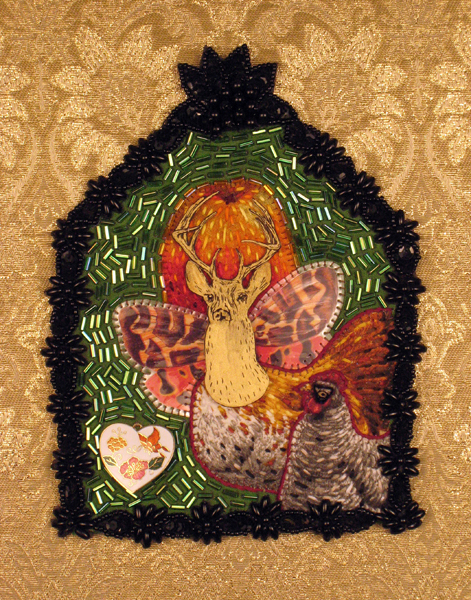 Text and images by Jennifer A. Reis
Text and images by Jennifer A. Reis
In a conversation inspired by the television show “Hoarders”, a good friend/fellow artist and myself decided there was a special breed of hoarder – the art maker and educator – who both obsessively collects and produces MORE objects from the objects they collect. This “super hoarder” is the possessor as well as creator of objects; stuff unendingly producing more stuff into infinity! I count myself among the ranks of these over-achievers of stuff.
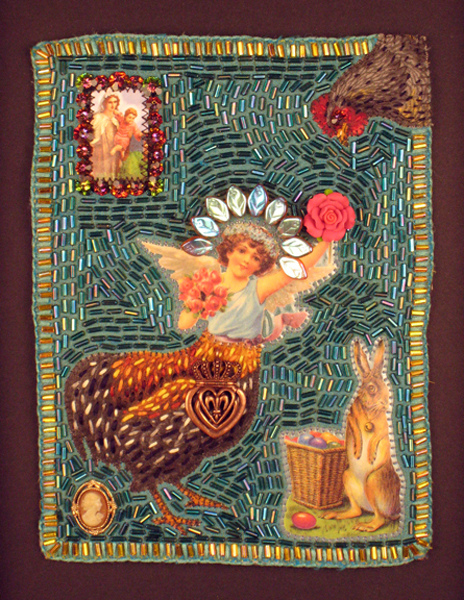 This is partially in jest. However, many artists I know often have those moments of deep mourning for supplies sold or given away during a fit of temporary tidiness. This regret seems to particularly plague those like myself who work in multiple media, including assemblage. It’s an emotion with analogous behaviors reinforced by the frequent “A HA!” moments of finding that perfect embellishment or found object that transforms a work that has previously been an unending struggle. In tandem with the reluctance to let things go is the regret of the “great thing not purchased”. Living in the hinterlands of Eastern Kentucky, much of the fantastic oddities and materials in my inventory have been gleaned from far-flung travel. Those terrific religious medals I waffled on purchasing at an outdoor antique market in Barcelona, Spain, are alas (sigh!) forever gone from my grasp.
This is partially in jest. However, many artists I know often have those moments of deep mourning for supplies sold or given away during a fit of temporary tidiness. This regret seems to particularly plague those like myself who work in multiple media, including assemblage. It’s an emotion with analogous behaviors reinforced by the frequent “A HA!” moments of finding that perfect embellishment or found object that transforms a work that has previously been an unending struggle. In tandem with the reluctance to let things go is the regret of the “great thing not purchased”. Living in the hinterlands of Eastern Kentucky, much of the fantastic oddities and materials in my inventory have been gleaned from far-flung travel. Those terrific religious medals I waffled on purchasing at an outdoor antique market in Barcelona, Spain, are alas (sigh!) forever gone from my grasp.
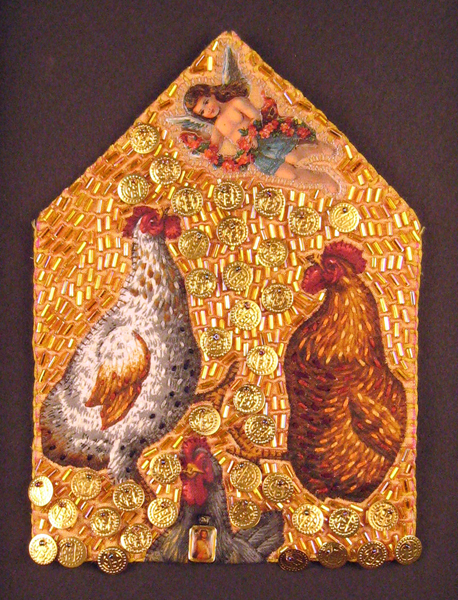 I consider myself an assemblage artist whose primary materials are textile-, stitch- and embellishment-oriented. My method of working, which will be the focus of the 2-day pre-conference workshop “Embellished Textile Assemblage” at Confluence: 2011 SDA International Textile Conference, is a combination of hand stitching, thread and bead embroidery, and incorporation of found objects. Though I have formal training (via art school) in drawing, painting and mixed media collage, I am self-taught when using textile media. I see fabric appliqué as shape and color; embroidery as line; embellishment as pattern and decoration. While I have sewn since my first lessons in quilting and crochet at a young age, the transition to using textile materials as an art medium came after leaving art school, when I became increasing frustrated with the inherent flatness in the works on paper I had previously made.
I consider myself an assemblage artist whose primary materials are textile-, stitch- and embellishment-oriented. My method of working, which will be the focus of the 2-day pre-conference workshop “Embellished Textile Assemblage” at Confluence: 2011 SDA International Textile Conference, is a combination of hand stitching, thread and bead embroidery, and incorporation of found objects. Though I have formal training (via art school) in drawing, painting and mixed media collage, I am self-taught when using textile media. I see fabric appliqué as shape and color; embroidery as line; embellishment as pattern and decoration. While I have sewn since my first lessons in quilting and crochet at a young age, the transition to using textile materials as an art medium came after leaving art school, when I became increasing frustrated with the inherent flatness in the works on paper I had previously made.
 Since the techniques I employ are fairly laborious – like applying sequin rosettes and beaded cabochon or stitching through tin cans and laminated imagery – there needs to be special attention placed on intuitive practice in what can feel like a plodding way of working. One method I use is what I call “The Colorforms Approach”, based on the plastic cutouts you can move around a glossy surfaced board that was one of my favorite childhood toys. I do this either flat on a table or pinned up on 4′ x 8’ sheets of foam insulation that cover my studio walls.
Since the techniques I employ are fairly laborious – like applying sequin rosettes and beaded cabochon or stitching through tin cans and laminated imagery – there needs to be special attention placed on intuitive practice in what can feel like a plodding way of working. One method I use is what I call “The Colorforms Approach”, based on the plastic cutouts you can move around a glossy surfaced board that was one of my favorite childhood toys. I do this either flat on a table or pinned up on 4′ x 8’ sheets of foam insulation that cover my studio walls.

 A piece might reside in “Colorforms Purgatory” for weeks – even months – as I continue to move the pieces around. The piece “B is For . . . .” entered this art limbo as a devotional to the German Dada collage and performance artist Hannah Hoch. The piece lingered there as I added, moved, and removed materials for weeks, and finally came together after the inspiration of adding vintage French sequins as the skirt and viewing the movie The Black Swan. For me, patience and flexibility is key to being open to the possibilities in a piece, rather than seizing up, stubbornly locking into an idea despite not “feeling it”, and then the piece (and me!) rapidly become staid.
A piece might reside in “Colorforms Purgatory” for weeks – even months – as I continue to move the pieces around. The piece “B is For . . . .” entered this art limbo as a devotional to the German Dada collage and performance artist Hannah Hoch. The piece lingered there as I added, moved, and removed materials for weeks, and finally came together after the inspiration of adding vintage French sequins as the skirt and viewing the movie The Black Swan. For me, patience and flexibility is key to being open to the possibilities in a piece, rather than seizing up, stubbornly locking into an idea despite not “feeling it”, and then the piece (and me!) rapidly become staid.
In the workshop “Embellished Textile Assemblages”, I will be emphasizing both the craft of stitching and bead embroidery as well as the ‘happy accidents’ of intuitive compositions and meaning that can arise from serendipitous material combinations. Enrolled artists are encouraged to bring a variety of objects/mementos that are visually and/or emotionally compelling. As an arts instructor, I have several goals for each participant:
 1) gain a new or enhanced visual media vocabulary
1) gain a new or enhanced visual media vocabulary
2) complete an artwork (a workshop “relic”!)
3) have the confidence to incorporate non-traditional materials in textile artworks in the future.
My web site at www.jenniferareis.com features much more information about my artwork and art/teaching philosophy. Please feel free to contact me directly about my work and/or workshop, and I look forward to meeting many fellow textile artists at Confluence!
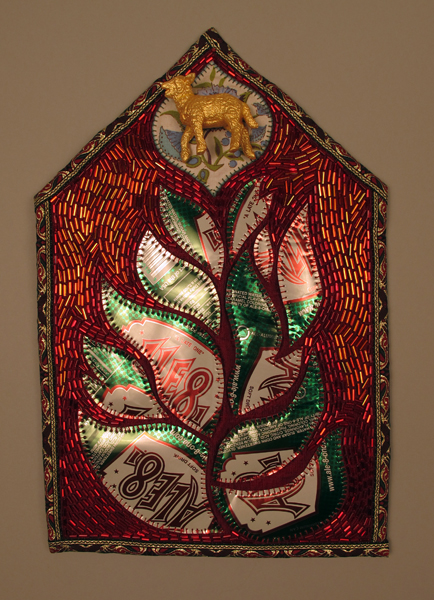 __________________________________
__________________________________
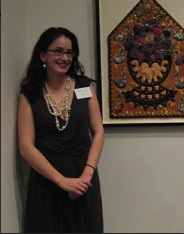 Jennifer A. Reis, currently faculty at Morehead State University, has undergraduate and graduate degrees in Studio Art and Museum Studies. Her work has been shown at the Kentucky Museum of Art and Craft, Carnegie Center for Art & History, National Quilt Museum, and the Dairy Barn Arts Center. Her work has been promoted in Art in America, ArtForum and FiberArts magazines, and she is featured in Creative Quilting with Beads, a Lark Books publication. She conducts workshops and lectures on embellished textiles at universities and arts organizations including the Society for Contemporary Craft, Craft Alliance, and the Kentucky Foundation for Women.
Jennifer A. Reis, currently faculty at Morehead State University, has undergraduate and graduate degrees in Studio Art and Museum Studies. Her work has been shown at the Kentucky Museum of Art and Craft, Carnegie Center for Art & History, National Quilt Museum, and the Dairy Barn Arts Center. Her work has been promoted in Art in America, ArtForum and FiberArts magazines, and she is featured in Creative Quilting with Beads, a Lark Books publication. She conducts workshops and lectures on embellished textiles at universities and arts organizations including the Society for Contemporary Craft, Craft Alliance, and the Kentucky Foundation for Women.



2 Comments
eleanor albanese says
February 25, 2011 at 11:32 am
Hello Jennifer: I was looking for details as to where and when this workshop is being held. As I live in Canada, I would need to plan well ahead. But I love your work and could possibly arrange to travel to take in a workshop. Eleanor
SDA-Enews says
March 8, 2011 at 10:25 am
You can find complete information on Jennifer's workshop on our new website, https://test.surfacedesign.org/subpage/workshops-tours From there, you can register for both the workshop and the conference. Thanks for your interest! Hope to see you at Confluence. Leesa Hubbell, SDA NewsBlog Editor
Related Blog Articles
Assemblage
“Stockyards Gallery First Annual Fiber Art Exhibit” by Mary Elmusa
Assemblage
“I Thought My Head Would Explode” by K. Johnson Bowles
Assemblage
Member Spotlight: Myrna Tatar